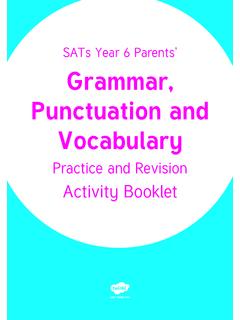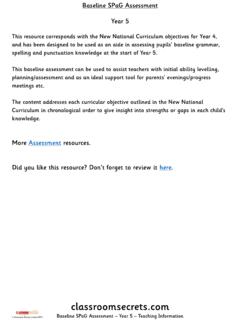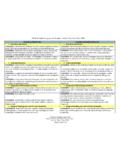Transcription of READING LITERARY (RL) READING INFORMATIONAL (RI) Key …
1 6th Grade English Language Arts Georgia Standards of Excellence (ELA GSE) Georgia Department of Education April 15, 2015 Page 1 of 5 READING LITERARY (RL) READING INFORMATIONAL (RI) Key Ideas and Details Key Ideas and Details ELAGSE6RL1: Cite textual evidence to support analysis of what the text says explicitly as well as inferences drawn from the text. ELAGSE6RI1: Cite textual evidence to support analysis of what the text says explicitly as well as inferences drawn from the text. ELAGSE6RL2: Determine a theme and/or central idea of a text and how it is conveyed through particular details; provide a summary of the text distinct from personal opinions or judgments.
2 ELAGSE6RI2: Determine a central idea of a text and how it is conveyed through particular detail s; pro vid e a summary of the text dis tinct from pers onal opin io ns or judgments. ELAGSE6RL3: Describe how a particular story s or drama s plot unfolds in a series of epis odes as well as how the characters re spond or change as the plot moves towards a resolution. ELAGSE6RI3: Analyze in detail how a key individual, event, or idea is introduced, ill ustrated, and elaborated in a text ( , through examples or anecdotes).
3 Craft and Structure Craft and Structure ELAGSE6RL4: Determine the meaning of words and phrases as they are used in a text, in cludin g fig urative and connotative meanin gs; analyze the impact of a specific word choice on meaning and tone. ELAGSE6RI4: Determine the meaning of words and phrases as they are used in a text, in cludin g fig urative, connotative, and technical meanin gs. ELAGSE6RL5: Analyze how a particular sentence, chapter, scene, or stanza fits into the overall structure of a text and contributes to the develo pment of the theme, settin g, or plot.
4 ELAGSE6RI5: Analyze how a particular sentence, paragraph, chapter, or section fits into the overall structure of a text and contributes to the develo pment of the ideas. ELAGSE6RL6: Explain how an author develops the point of view of the narrator or speaker in a text. ELAGSE6RI6: Determine an author s point of view or purpose in a text and explain how it is conveyed in the text. Integration of Knowledge and Ideas Integration of Knowledge and Ideas ELAGSE6RL7: Compare and contrast the experience of READING a story, drama, or poem to li stening to or viewin g an audio, vid eo, or li ve version of the text, includin g contrasting what they see and hear when re adin g the text to what they perc eive when they listen or watch.
5 ELAGSE6RI7: Integrate information presented in different media or formats ( , vis ually, quantitatively ) as well as in words to develop a cohere nt understandin g of a topic or issue. ELAGSE6RL8: (Not applicable to literature) ELAGSE6RI8: Trace and evaluate the argument and specific claims in a text, dis tinguis hin g claims that are supported by re asons and evidence from claims that are not. ELAGSE6RL9: Compare and contrast texts in different forms or genres ( , stories and poems; historical novels and fantasy stories) in terms of their approaches to similar themes and topics.
6 ELAGSE6RI9: Compare and contrast one author s presentation of events with that of another ( , a memoir written by and a biography on the same pers on). Range of READING and Level of Text Complexity Range of READING and Level of Text Complexity ELAGSE6RL10: By the end of the year, read and comprehend literature, including stori es, dra mas, and poems, in the grades 6-8 text complexity band pro fici ently, with scaffolding as needed at the high end of the range. ELAGSE6RI10: By the end of the year, read and comprehend LITERARY nonfiction in the grades 6-8 text comple xity band pro fici ently, with scaffolding as needed at the high end of the range.
7 6th Grade English Language Arts Georgia Standards of Excellence (ELA GSE) Georgia Department of Education April 15, 2015 Page 2 of 5 Text Types and Purposes WRITING (W) ELAGSE6W1: Write arguments to support claims with clear reasons and relevant evidence. a. Introduce claim(s) and organize the reasons and evidence clearly. b. Support claim(s) with clear reasons and relevant evi dence, using credible sources and demonstratin g an understanding of the topic or text. c. Use words, phrases, and clauses to clarify the rela tionships among claim(s) and reasons.
8 D. Establi sh and maintain a formal style . e. Provi de a concluding statement or section that foll ows from the argument presented. ELAGSE6W2: Write informative/expla natory texts to examine a topic and convey ideas, concepts, and information through the selection, organization, and analysis of relevant content. a. Introduce a topic; organize ideas, concepts, and information, using strategies such as definition, cla ssification, comparis on/contrast, and cause/effect; include formattin g ( , headings), graphics ( , charts, tables), and multimedia when useful to aiding comprehension.
9 B. Develop the topic with relevant facts, definitions, concrete details, quotations, or other information and examples. c. Use appropriate transitions to clarify the relationships among ideas and concepts. d. Use precise la nguage and domain-specific vocabulary to inform about or explain the topic. e. Establi sh and maintain a formal style . f. Provi de a concluding statement or section that foll ows from the information or explanation presented. ELAGSE6W3: Write narratives to develop real or imagined experiences or events using effective technique, relevant descriptive details, and well -structured event sequences.
10 A. Engage and orient the reader by establishing a context and introducing a narrator and/or characters; organize an event sequence that unfolds naturally and logically. b. Use narrative techniques, such as dialogue, pacing, and descrip tion, to develop experiences, events, and/or characters. c. Use a varie ty of transition words, phrases, and cla uses to convey sequence and signal shifts from one time frame or setting to another. d. Use precise words and phrases, relevant descriptive details, and sensory language to convey experiences and events.
















